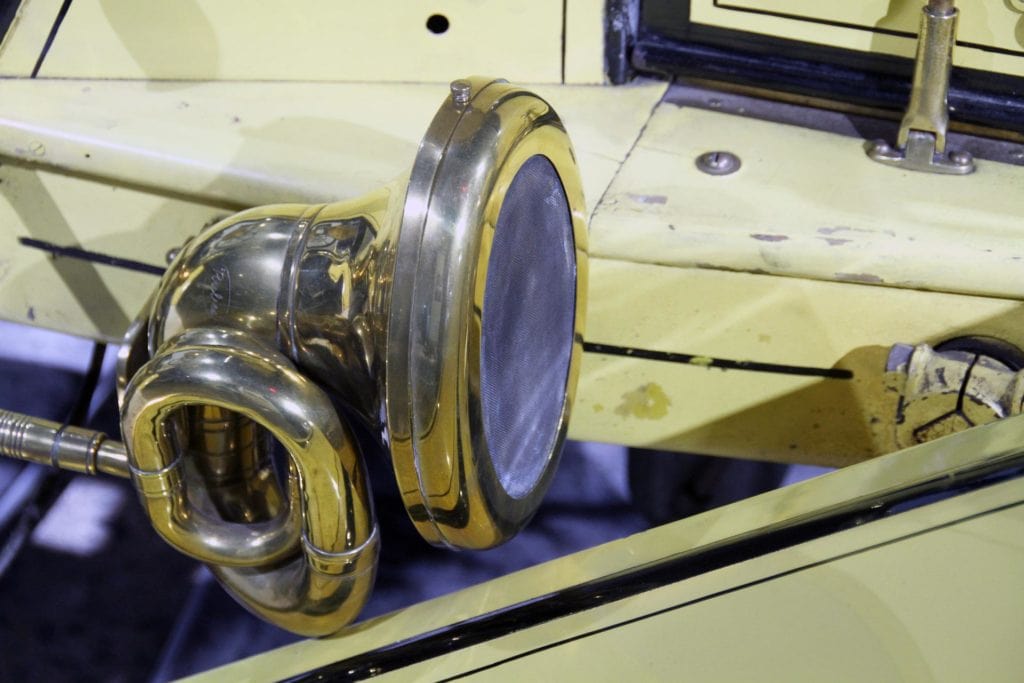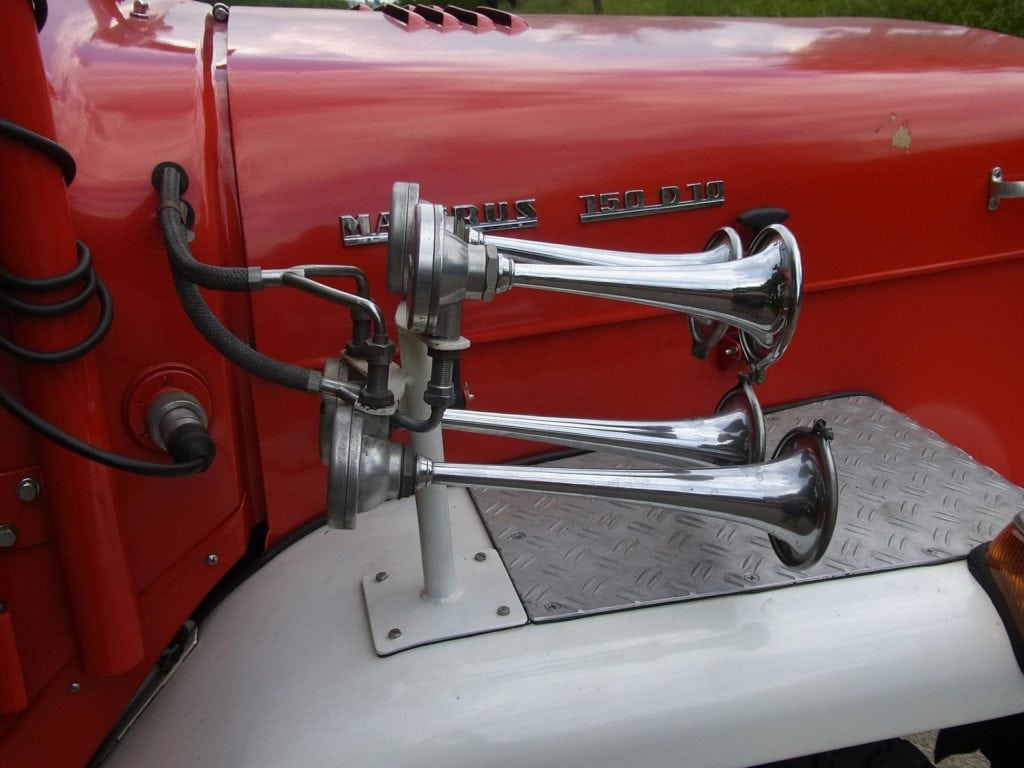How Loud Is a Car Horn in Decibels (dB)? With Noise Comparison Chart
-

- Last updated:

Car horns have been around for over a century, and all motor vehicles are required to have them by law. And why do we need them? Because, as drivers, there are times when we need to warn other drivers and pedestrians of our presence and potential hazards. In fact, any motor vehicle, train, or water vessel must have a functioning car horn to operate. But exactly how loud does a car horn need to be? And what is a decibel? On average, the typical car horn blows at about 90-150 decibels. Continue reading to learn more.
How Many Decibels Is a Car Horn?
A decibel is a unit of measurement used to measure the intensity of sound. To give you a bit of context, let’s do a quick comparison. Your average person talks at about 60 decibels, while a whispered conversation is around 30 decibels. The motor engine of an average vehicle is about 95 decibels, and the typical air conditioning fan blows 25-70 decibels.
Note that noises above 70 decibels over extended periods of time can actually damage your hearing, which is why it’s recommended that you only blow your horn in short, sporadic bursts. Horns are made to emit loud noises that can be heard over radios, car engines, and road construction. In other words, they’re designed to potentially save lives.
| Common Sounds | Decibels (dB) |
| Soft whispers | 30 dB |
| Normal conversation | 60 dB |
| Thunder | 120 dB |
| Lawn mower | 85 dB |
| Chainsaw | 120 dB |
| Car Horn | 90-150 dB |
How Car Horns Work
You may be surprised to find that the car horn really hasn’t evolved too much over the past few years–though it’s much different than its original version–the klaxon. And while there have been some small changes in the appearance and sound of your typical car horn, the design and overall features of car horns are pretty much the same.

The Klaxon
One of the biggest pioneers in car horn manufacturing was Miller Hutchinson. Around 1910 he was inspired to create a better car horn after almost hitting a pedestrian while driving down the road. He wanted to make car horns louder and give them an overall harsher sound. This inspired the invention of the klaxon.
You’ve probably heard this type of horn in any 1930 movie, as it has the easily recognizable “uhoooga” sound. This car horn became popular almost immediately and was used on the ever-present Model T vehicles that were prevalent at the time. However, in the late 1930s, the klaxon was surpassed by the invention of electric car horns.
Modern Car Horns
With modern electric-based car horns, the action needed to blow the horn is a simple press to the front of your steering wheel. When you press the horn with your hand, an electric current is sent to an electromagnet within the steering wheel.
This creates a magnetic field around a metal diaphragm that will flex as a result. As the diaphragm flexes, it vibrates, which creates the sound. Once the diaphragm returns to its original flat position, the electronic current stops, and thus the sound stops. As you can see, it’s a fairly straightforward design.
Cost to Fix Car Horn
The cost to fix a weakened or broken car horn can range anywhere from $100 to over $250, depending on the cause of the issue. For example, small wiring issues are usually on the less expensive side, while airbag-related issues may cost a bit more due to the labor needed to remove the bag or the steering wheel. And remember that in some cases, you may be able to save yourself a few hundred dollars in repair costs by sorting through the issue yourself.

Why Has My Car Horn Stopped Working?
While a horn is designed to last the entire lifetime of a vehicle, it can run into issues at some point. For example, the horn’s sound may weaken or become distorted, or it may stop working altogether. If the car horn becomes weak or stopsworking altogether, it’s usually due to issues such as a disconnected fuse, internal switches, or it may be the horn circuit itself. Here are a few common reasons why a car’s horn may stop working.
Blown Fuse or Coils
The horn in most vehicles sits at the top front area of the engine. This means that it’s often exposed to things such as road chemicals (such as windshield wiper fluid), precipitation, and debris. Over time, these things can cause the electric coils in the horn to short out, resulting in a horn that sounds weak or stopped working altogether.
If your horn suddenly stops working, the best thing to do is to refer to your manual and check for a blown fuse. You can usually tell if the fuse is blown, as it will have black coils or connectors. You can also test the fuse using a multimeter.
This instrument is pretty easy to use and has metal nodes that you can place on the fuse’s contacts to determine if it is able to conduct electricity. If the reading shows no signs of electricity, then you’ll need to replace the fuse. Overall, this is a fairly easy and inexpensive fix.
Faulty Horn Relay
The horn switch is an electrical component that actually activates the horn. It’s located inside the horn circuit and it serves to control the power of the horn. When you press the horn, the relay receives an electrical current that allows the horn to emit sound.
The relay is located in the fuse box beneath your hood, and if it or its connected fuse malfunctions, the horn will not work. This relay can be replaced within a matter of minutes. You can do it yourself if you have your car manual or hire a mechanic to do it. In any event, it should be another simple fix.
Clock Spring Issues
The clock spring within the horn allows it to maintain its electrical connection as the wheel rotates from left to right. However, the clock spring can become faulty over time, similar to any other component. When it does, the connection will become interrupted and it will prevent the horn from emitting any sounds when you press the steering wheel. If there’s an issue with the clock spring, you may also see a light on your dash warning of issues with the airbag, as the clock spring is connected to it.
If the clock spring is faulty, which can happen when its connectors go bad, you’ll need to replace the entire component. In some cases, it may require removing the steering wheel as well as the airbag, which can cause repair costs to rack up. But with some vehicles, you may be able to perform this task yourself.
Wiring Issues
The issue can also be as simple as bad wiring with the horn circuit. The wiring within the circuit can become faulty due to loose connections, corrosion, a bad ground connection, broken wires, or deflated insulation.
In many cases, you may not know exactly which wire is causing the issue with the horn, so it’s generally best to have a mechanic take a look so they can track down the culprit. A wiring issue is usually an easy fix as they don’t require much effort to replace, and most of them only cost anywhere from $5 to $15 to replace.
Airbag Issues
If your steering wheel’s airbag has been deployed, it may cause issues with the horn operation. Typically, this happens during an accident, and afterward, the airbag will need to be replaced and reinstalled. However, mechanics can sometimes install the airbag haphazardly, causing it to disengage the horn connection. In which case, you will need to have a mechanic open up the steering wheel again to reposition it.
In Conclusion
As you can see, the car horns are built to be quiet enough to be safe for your ears, but loud enough to be heard by passing motorists and pedestrians to prevent potential driving hazards. It’s important to mention that you can always change your horn if you aren’t satisfied with it.
Meaning that if you want a louder horn, you can find a car dealership that has various horn kits available for you to purchase. Before purchasing horns that are especially loud, you may want to check local and state motor vehicle laws to ensure that yours is in step with them.
Featured Image Credit: Pixabay
Contents


